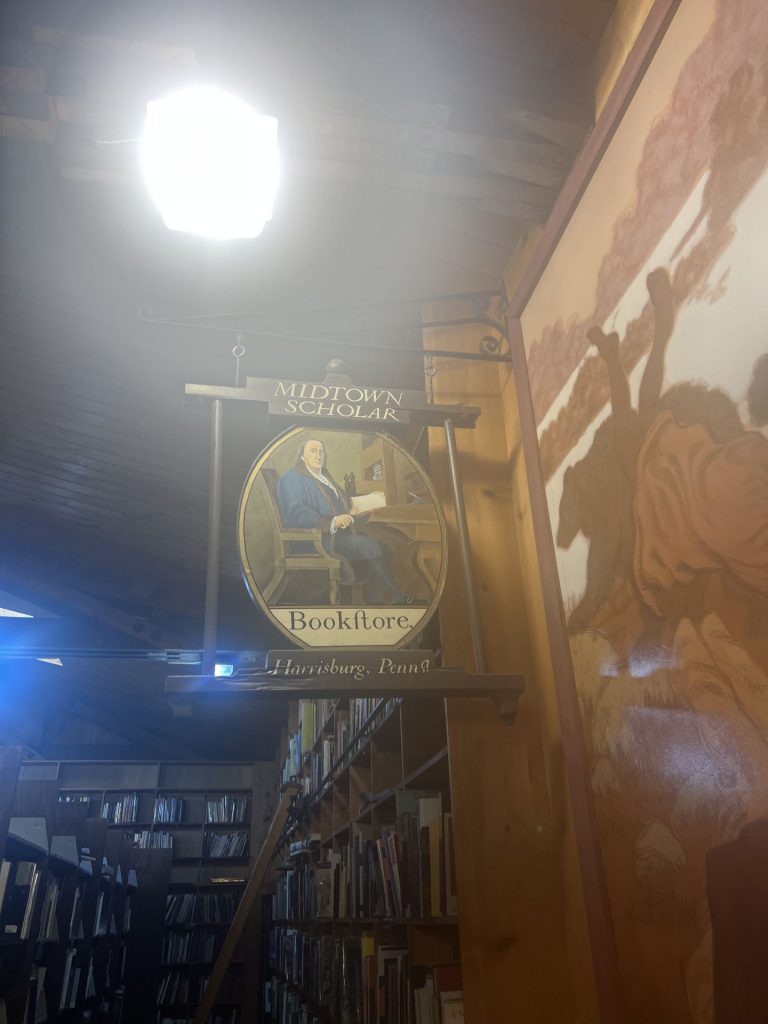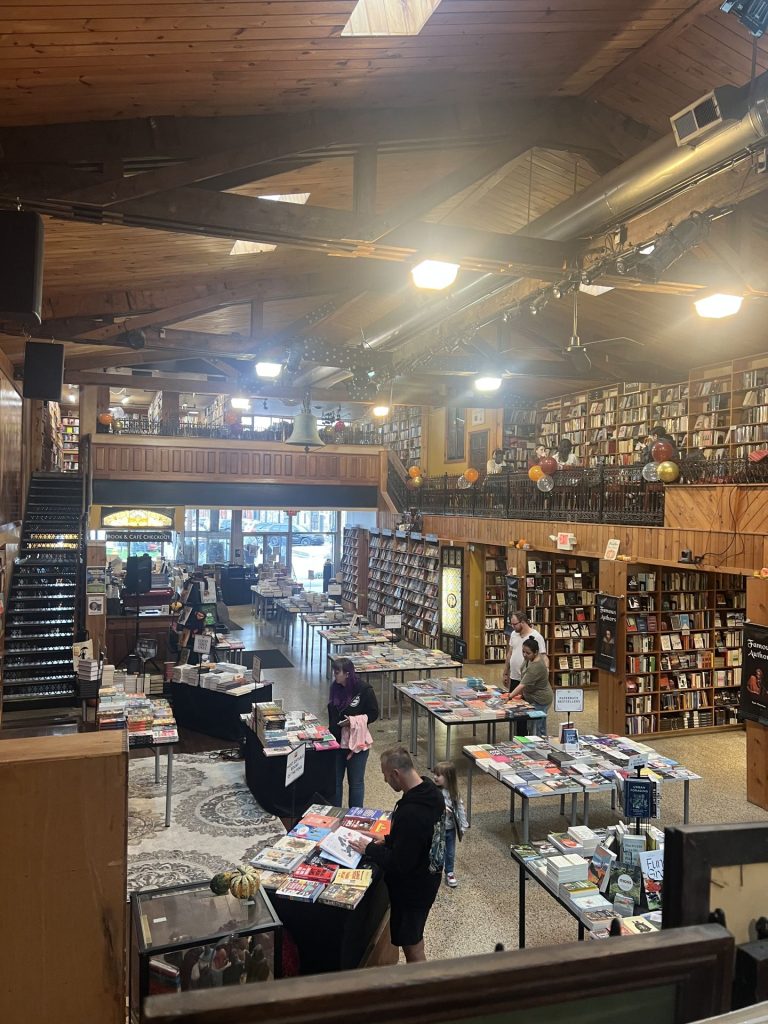Midtown Scholar: A Maze of Knowledge and History

Growing up in my snobby hometown on Long Island, there was only one bookstore near me. My town fondly nicknamed “The Playground of the Rich and Famous,” does not allow chain stores (besides a Starbucks conveniently placed right next to the only bookstore) so we had a local chain, Book Hampton. It had one other location, but that location has since closed its doors. I was an avid reader when I was young, gobbling up books and always asking for more. So, my mother, also an avid reader, would go down to the bookstore and get me books about fairies and magic tree houses. However, it never felt like a place where I was welcome. The vacationers would always look at me like I wasn’t supposed to be there. The employees tried their best but could never overshadow the feeling of being looked down upon by people who could probably buy my existence. When I traveled down to Harrisburg a week ago, however, I felt the complete opposite of what I felt when I still had a bowl haircut.
Before I even walked in, I noticed all of the books that lined the street leading into Midtown Scholar. It felt like the store was taking these books and thrusting them at the people walking by as if to say, “Come! Read our books! Gain some knowledge!” Walking in, I was hit with the smell of coffee and pastries and greeted with a massive space filled with more books than anyone could read in a lifetime. To my right was the counter where you order your café items and check out your books, prints, or merchandise. The decision to combine both lines was a smart move by Midtown Scholar, as while you’re checking out, why not order a coffee or tea to go?
The space in front of me was occupied by tables full of books facing up, so that the customer could see the covers of the book. To my left were bookshelves that formed enclaves, which was very interesting and a good way to utilize space. Along the right wall was a stage. I traveled to the bookstore during the Harrisburg Book Festival, so the staff were running around like busy bees setting up chairs in front of the stage for a reading done by an author. Along the stage, they had a table themed with thrillers and horror stories for the Halloween season. Next to the stage and above the café checkout area was a staircase that went to the fiction section upstairs. Towards the back of the store was another, bigger staircase that led upstairs to the veranda and two smaller staircases on either side of it that led downstairs.
Up the stairs were columns upon columns of art history in the mediums of both books and prints. This is also where they had the majority of their wearable merchandise like shirts, zip-up hoodies, and hats. The books had varying sections from actual art history like biographies of artists and their pieces of works, to theater history dating back to Greek comedies and tragedies. While I personally was not interested in art history, just the sheer size of the collection was impressive on its own.

To the left of the stairs was a catwalk-like structure that had a bunch of tables to sit at and observe the store below. On the wall was a bookshelf that featured famous authors. It was a mix of traditional bookshelf with the books facing in and upright and books facing out. A lot of the books facing out were very popular writers and their most famous books, like Sylvia Plath’s The Bell Jar and J.D. Sallinger’s The Catcher in the Rye. This space with the tables next to the bookshelves reminded me of our reading Bookshelf by Lydia Pyne. While the tables and the shelves are separated by a walkway, it made me think about how libraries used to chain books to the shelf so that a reader could only read the book in that spot. I thought about how far bookstores and libraries have come since then. In a store that big and bustling with people, someone could nick a book off the shelf, bring it over to the table to read, and then just put it in their bag and walk out of the store. However, the freedom to be able to read a book at those tables was a touch that was not available in my buttoned-up hometown bookstore, and I appreciated that.
At the end of the walkway was a section for literary criticism. I also was super interested in it, but my groupmate was. I was more interested in the section next to it, the fiction section. They had almost every book imaginable in those rows. Along the railing was also another section, science fiction. The best part of the upstairs part of the store was the fact that every book there was used. Most of them, especially the fiction books, looked brand new. Benjamin wrote in Unpacking My Library, “I am not exaggerating when I say that to a true collector the acquisition of an old book is its rebirth.” Midtown Scholar is a collector’s heaven. Some of the books were older than my parents, and their parent’s parents. It was fascinating and if I ever develop a collection of antique books, Midtown Scholar will be my first stop.
Going down the stairs from the main level to go to the basement area, the room is rows of American history. This was impressive alone until My friend and I turned around to see yet another staircase that led even lower, with sections of world history. I loved the layout of the world history section; it was divided into different parts of the world. I was browsing through when I saw a section labeled “British history” and then furiously looked down the long aisle to make sure that Irish history was separate, (it was) because it often is lumped in with British literature, which I, as a person with Irish descent, hates. This goes to show how thorough Midtown Scholar is with their categorization and care. You can tell that the owners care about the precise details of their books and customers like me, or they wouldn’t have so meticulously put these books into the order they are.
Midtown Scholar is a place that I was already excited to visit, but I never expected to like the experience that much. It was very welcoming and inviting, the opposite of what I am used to. They use the massive space in a way that is so efficient for both the customer and the staff. The sense of place is so strong at Midtown Scholar. They know who they are and who they will always be. They will always be passionate about bookkeeping, history, and keeping both of those arts alive. Harrisburg is lucky to have such a rich environment where all are welcome.
Citations
Benjamin, Walter. Unpacking My Library. Shocken Books, 1931.
Pyne, Lydia. Bookshelf. Bloomsbury Academic, 2016.
Photo Citations
Branche, Jessica. Main Floor. 20 Oct. 2023. Harrisburg.
Branche, Jessica. Midtown Scholar Sign, 20 Oct. 2023. Harrisburg

0 Comments